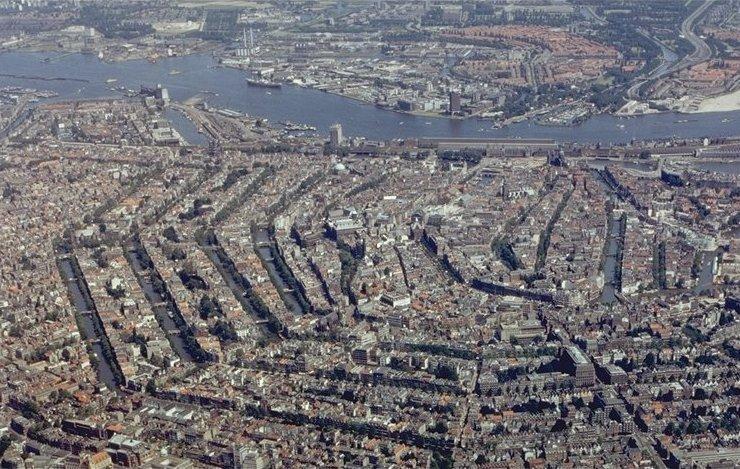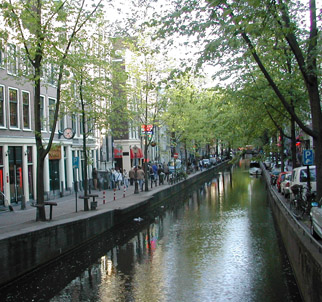I find this History fascinanting....
++++++++++++++++++++++++++++
The Historical Context
A series of complex events which historians call the Revolt of the Netherlands (1566-1648) allowed Amsterdam to emerge as the dominant city in the Low Countries. The seven northern provinces of the Netherlands (17 provinces in all) rebelled against Spanish rule and won political independence in 1609. In the war with Spain, the Spanish armies commanded by the Duke of Alva destroyed Amsterdam's economic rivals in the south, including Antwerp. Accordingly, Amsterdam's freedom and her large population made her the de facto capital of Holland.
In addition to possessing political independence, Amsterdam was a major hub of European commerce after 1609. One reason was the decline of Antwerp, which was during the sixteenth century a center of banking and international commerce. The decline began in 1576, when the city was sacked by Spanish troops and some 6,000 citizens killed. To make matters worse, Antwerp was occupied in 1585 following a fourteen month siege, which had closed her ports and stopped trade.
Economic Basis for Amsterdam's Prosperity
Amsterdam, first of all, welcome refugees, including a significant number who had fled Antwerp, bring capital and commercial skills with them. Secondly, merchants in Amsterdam were eager to seize opportunities to make money. These included purchasing grain and other foodstuffs in Poland and eastern Europe and selling food to those experiencing shortages. The Dutch developed industries to supply export goods to colonies, a practice not followed by the Spanish and Portuguese, who then had to purchases such goods as textiles, metalwork products, armaments, furniture, rope, tar, timber, and other items. Third, they were willing to take risks and plunder Spanish and Portuguese treasure fleets. They also built ships to sell or lease and outfitted ships purchased elsewhere.
Amsterdam's Advantages.
Amsterdam had a superb merchant marine and the means to protect its ships. About 1650, the Dutch owned 50% of the merchant ships in Europe. Dutch merchants were prepared to trade in virtually any commodity in world commerce. Accordingly, Amsterdam prices became a world-wide reference guide. Further, the Dutch provided a complete assortment of commercial services, ranging from credit to insurance to brokering to law. The Dutch were hard working and efficient. Ships that berthed in Amsterdam harbor could unloaded and reloaded within a few days. In Amsterdam, a merchant could purchase just about anything, including grain, naval supplies, armaments, and fish. Moreover, the Dutch controlled metal imports from Sweden, wool from Spanish sheep, salt from Denmark, and unfinished woolen clothing from England. Many of these imports were raw materials or semi-finished goods. They were then finished in Amsterdam and exported at a considerable profit.
Amsterdam's Overseas Trading Companies
The ambition of Dutch merchants was to break the monopoly held by Spain and Portugal over the spice trade. To this end, the Dutch founded the Company of Far Lands, and the Dutch managed to penetrate the East Indes and establish trading relationships. As the trade thrived, the Dutch found they were competing against each other, thus harming themselves. To put an end to this situation, the Dutch founded the United Netherlands Chartered East India Company in 1602; its initial capital was 6.5 million florins, 50% of which came from Amsterdam. This company claimed a monopoly over trade from the Cape of Good Hope to the Straits of Magellan. It could make war and peace, build fortresses, seize foreign vessels, and coin money. Amsterdam merchants dominated the Company. An annual fleet was sent out, and it seized areas in which the Dutch wished to trade, including Cape Town, parts of India, Batavia on Java, the Moluccas, and Nagasaki, Japan. In 1621, the Dutch West India Company was founded to monopolize trade with the New World. Its captured the entire Spanish treasure fleet in Cuba in 1628. They also tried but failed to colonize New York. The result of the activities of the East and West India Companies was a vast increase in the quantity as well as the quality of the goods available. The character of the Dutch merchants who thrived in this competitive atmosphere was calculating, greedy, tight-fisted, and frugal; they were ready to forego immediate pleasures for long-term gain, and they often ignored religion and patriotism when they interfered with economic activity. According to the contemporary poet, Joost van der Vondel: "For love of gain the wide world's harbors we explore."
http://www.uncp.edu/home/rwb/Amsterdam_l.html



